ANDERSON DD 411
Ship Name and Designation History
This section lists the names and designations that the ship had during its lifetime. The list is in chronological order.
- USS ANDERSON DD-411
Commissioned 19 May 1939 - Decommissioned 22 June 1946
Sunk 1 July 1946 in Atomic Bomb Test Able at Bikini Atoll
Struck from Naval Register 24 September 1946
Sims Class Destroyer
Keel Laid 15 November 1937 - Launched 4 February 1939
Naval Covers
This section lists active links to the pages displaying covers associated with the ship. There should be a separate set of pages for each incarnation of the ship (ie, for each entry in the "Ship Name and Designation History" section). Covers should be presented in chronological order (or as best as can be determined).
Since a ship may have many covers, they may be split among many pages so it doesn't take forever for the pages to load. Each page link should be accompanied by a date range for covers on that page.
- USS Anderson DD-411 Covers Page 1 (1937-1943, 2002)
Postmarks
This section lists examples of the postmarks used by the ship. There should be a separate set of postmarks for each incarnation of the ship (ie, for each entry in the "Ship Name and Designation History" section). Within each set, the postmarks should be listed in order of their classification type. If more than one postmark has the same classification, then they should be further sorted by date of earliest known usage.
A postmark should not be included unless accompanied by a close-up image and/or an
image of a cover showing that postmark. Date ranges MUST be based ONLY ON COVERS IN
THE MUSEUM and are expected to change as more covers are added.
>>> If you have a better example for any of the postmarks, please feel free to replace the
existing example.
|
Postmark Type |
Postmark Date |
Thumbnail Link To Postmark Image |
Thumbnail Link To Cover Image |
|---|
Post Office Established 19 May 1939 - Disestablished 15 January 1946
|
Locy Type |
1939-05-19 |
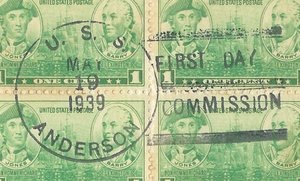 |
 |
Commissioning, cachet by Ralph A. Weiss
|
Locy Type 2(n) |
1946-04-01 |
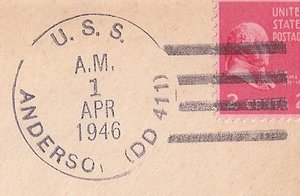 |
 |
Postmark used after the official post office closing date of 15 January 1946.
|
Locy Type 2# |
1945-10-26 |
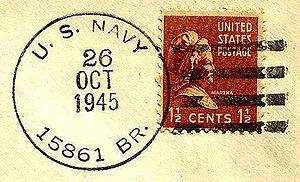 |
 |
Note:
|
Locy Type |
1939-11-01 |
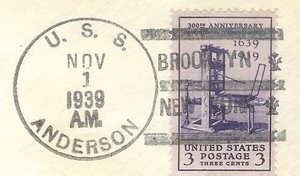 |
 |
Note:
|
Locy Type |
1943-06-05 |
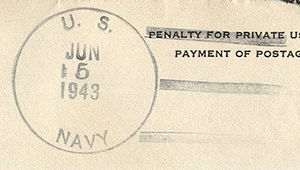 |
|
Note:
|
Locy Type 9v |
1939-11-02 |
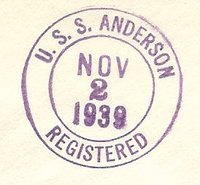 |
 |
Note:
|
Locy Type 9x |
1939-11-01 |
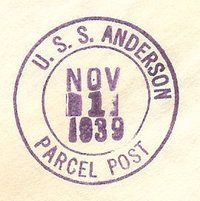 |
 |
Note:
|
Locy Type F |
1940-05-12 |
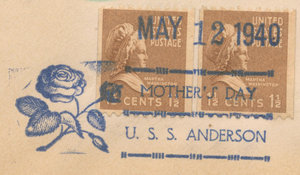 |
 |
Note the different date style between this postmark and the Type F below.
|
Locy Type F |
1940-05-12 |
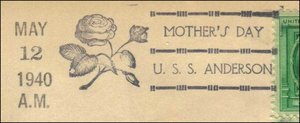 |
 |
Mother's Day
Cover illustration courtesy of Gary Denis.
|
Locy Type |
1946-06-22 |
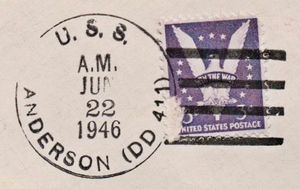 |
 |
Decommissioning. Add-on cachet by Richard F. Hoffner
Non Postal Marking
|
U.S.N. and Stars |
1940-05-12 |
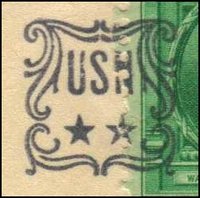 |
 |
Non-Postal marking seen on the 12 May 1940 Mother's Day cover.
Other Information
USS ANDERSON earned 10 Battle Stars for WWII service
NAMESAKE - Admiral Edwin Alexander Anderson, Jr., USN (16 July 1860 - 23 September 1933)
Anderson graduated from the U.S. Naval Academy in 1882. Two years' sea duty on the Sloop of War KEARSARGE and the Gunboat ALLIANCE was followed by promotion to Ensign in 1884 and service on USS QUINNEBAUG ID-1687 in European waters. From 1888 to 1896 he had survey and hydrographic assignments, among them a tour on the research steamer ALBATROSS. Anderson attained the rank of Lieutenant (Junior Grade) in September 1894. In early 1897, he reported on board the Cruiser USS MARBLEHEAD C-11 and was promoted to Lieutenant in March 1898. On May 11 1898, during the Spanish-American War, he led the MARBLEHEAD boat parties that helped cut the communication cables off Cienfugos, Cuba. Later in the war Anderson delivered the Spanish vessel ADULA to Savannah, Georgia, and in late 1898 and early 1899 commanded captured Spanish gunboats. Lieutenant Anderson was next assigned to the Naval Torpedo Station at Newport, Rhode Island, and in 1901-1902 commanded USS NASHAN. In 1903 he served in the Far East, commanding the former Spanish gunboats DON JUAN de AUSTRIA and ISLA de CUBA as well as reaching the rank of Lieutenant Commander. Tours at the Washington Navy Yard and on USS PENNSYLVANIA ACR-4 followed. In 1906-1907 he led the Second Torpedo Flotilla and received promotion to Commander. After recruiting duty at Cincinnati, Ohio, service at the Mare Island Navy Yard, California, and command of the Gunboat USS YORKTOWN PG-1, in July 1911 Anderson was promoted to Captain. He then commanded the Battleships USS IOWA BB-4 and USS NEW HAMPSHIRE BB-25. While in the latter ship, he participated the intervention at Vera Cruz, Mexico, leading the Second Seaman Regiment in combat ashore in April 1914. For his "extraordinary heroism in battle" at that time, he was awarded Medal of Honor. Captain Anderson attended the Naval War College in 1915-1916 and was Supervisor of Naval Auxiliaries at Norfolk, Virginia from late 1916 into the first months of World War I. Temporarily promoted to Rear Admiral in May 1917, his performance as Commander, Patrol Squadron ONE was recognized with the award of the Distinguished Service Medal. His flag rank became permanent in November 1918 and was followed by assignments as commander of an Atlantic Fleet cruiser division and, from November 1919 to May 1922, as Commandant, Sixth Naval District, headquartered at Charleston, South Carolina. He became Commander in Chief, Asiatic Fleet in August 1922, with the temporary rank of Admiral. When a severe earthquake rocked Japan in September 1923, Anderson acted quickly, sending ships to help the devastated cities of Tokyo and Yokohama. A month later, Anderson returned to the United States and served in the Office of the Chief of Naval Operations until his retirement, as a Rear Admiral, in March 1924. Edwin A. Anderson died on September 23 1933 at his home at Masonboro Sound, Wilmington, North Carolina and is buried at Arlington National Cemetery, Arlington, Virginia.
The ships sponsor was Mrs. Mertie Lorain Anderson, widow of Admiral Anderson.
If you have images or information to add to this page, then either contact the Curator or edit this page yourself and add it. See Editing Ship Pages for detailed information on editing this page.
Copyright 2025 Naval Cover Museum
